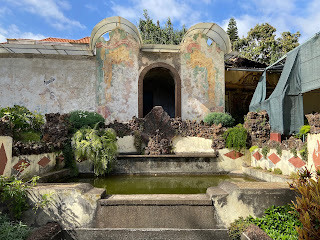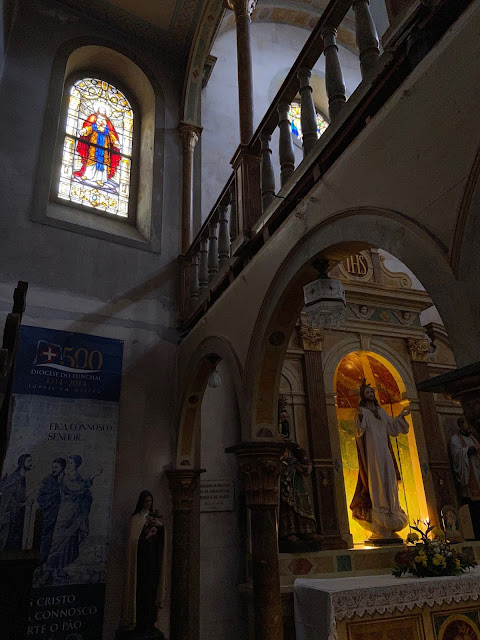Madeira is a small island far enough from the coast of Africa to say it is in the middle of the ocean. Donna’s family (father's grandparents) is originally from Funchal, and we are traveling with her third cousin, José Miguel, to explore and learn about the place. As luck would have it, José Miguel’s ninety-eight year old aunt and her immediate family own and run a hotel near the port.
The hotel includes the old family compound and gardens, new hotel structures with guest rooms, along with a little church. Unfortunately, the complex is now surrounded by tall and ‘modern’ tourist hotels (which can be seen hovering over the church). Views from the gardens to the hills are long past; there is just a wall of endless, curving hotel balconies. And because of some missed real estate opportunity, local hero Cristiano Ronaldo has been able to insert a grey and white box, blocking the sea views from the upper pool.
The hotel is near Parque de Santa Catarina. On the map, it looks like it’s set along the broad boardwalk along the port, but it is several dozen feet up a sheer stone rise. Along the seaside, there is a extra-wide paved plaza, and an extra-long hotel. We learn that Ronaldo has somehow turned the planned cruise port into the CR7 hotel, as well as a museum (to CR7), and there is a statue of himself in the plaza - a hero and a corporation. The airport is named for him, too.
After lunch, we decide to walk to the Fortaleza de São João Baptista do Pico. It will give us a good introduction and a big view of the city. The streets and alleys leading to the Fortaleza are steep enough that the sidewalks are stairs. The sun is stronger, and the air heavier than Lisbon. The weather app suggests the difference should be minimal, but it is quite significant. The structure atop its hill is picturesque, in an imposing way, but not all that interesting when we get there. The local curators have set aside a dark hall inside the Fortaleza and made a good effort to enliven its history; it’s not really impactful. But the views are wonderful.
We head down the hill to the Museu Qunita das Cruzes, a large, old manor home. We are making our way to the Convento de Santa Clara, and this Museu is on the route. We don’t enter the Quinta, but we do enjoy the wonderful gardens, with some imaginative follies and several ancient-looking trees.
Well, we find that the Convento is closed for renovations, so we decide to enter the Casa-Museu Frederico de Freitas, with no idea what to expect. Past the entry gate, there is a splash fountain and a ramp up to a courtyard. You can choose the Casa da Calçadas (the noble family that owned the house) or the Casa dos Azulejos. We choose Azulejos, and find several levels of tantalizing tiles, arranged in cases for horizontal viewing (floor, counter, and ceiling heights), as well as panels on the walls or on stands - very eclectic, and arranged by country and age. Sorry, no photos are allowed. These are accompanied by a few videos showing the tiles in-situ as well as behind the scenes material. There are also several mirror boxes where patterned panels are multiplied with reflections.
The manor house is also interesting, with lots of little collections in very grand rooms: saint statues, nativities, books, mugs (yes, mugs - so many mugs), ivory carvings, and more. There is also a small garden above street level. In all, this is a captivating small museum, with lots of eclectic sections - more like an anthology than a novel.
Next door to the Museu (the campanário is basically part of the garden) is the Igreja de São Pedro. Though small in scale, the church has a fully tiled nave, a luminous altarpiece, and a captivating, Renaissance-style side chapel. I particularly enjoy the chapel as the pews are set parallel to the colonnades, so there’s no way to ignore the architecture. The stained glass panels are excellent and the back-lit, ‘hovering’ Jesus is set upon a cloud and held, mid-flight, in a marbleized alcove. The inverted volutes of the column capitals release the weight and seem to spring him upward.
At dinner we learn that all these places are meaningful to José Miguel. Besides being able to catalog the furniture in the hotel, he took his first communion in São Pedro and played in the Frederico de Freitas as a boy. He recalls a time before the Casa da Calçadas became a museum - the mugs were off-limits even then.



















No comments:
Post a Comment